Azure Native Gateway API with Application Gateway for containers
Hi!
After a little (and definitly unfinished) incursion in Kubernetes (or should I say Linux) native security features, we’re going back to Gateway API stuffs, and specifically Azure related Gateway API with the Application Gateway for Containers.
There’s a lot of reading about this already, but as I said in the past, this blog also aimed o help me summarize stuff for myself so… Application Gateway for containers, here we come.
Our Agenda will be:
- Components of the Application Gateway for containers
- Prerequisites and deployment on an AKS cluster with Azure CNI overlay powered by Cilium
- Managing Gateway and HTTP routes with AGC
- Conclusion
Let’s get started!
1. Components of the Application Gateway for Containers
Application Gateway for Containers, or AGC for short, is the successor to Azure’s own implementation of the Ingress Controller, the formerly (and also a little bit unfamous 🤫) Application Gateway Ingress Controller (AGIC).
Under the hood, some similarities. AGC is an L7 load balancing solution aimed to provides such capabilities for K8S hosted workloads. As the name implies, because the (regionalized) L7 LB in Azure is Application Gateway, it comes without surprise that we’re still relying on this platform service for AGC.
Except that, as opposite to AGIC, the object is much more managed, and as a corollary much more abstracted than with its predecessor. Indeed, creating an AGC will show in Azure a corresponding resource (more detail on this later), classified in the Application Gateway, but with a brand new icon.
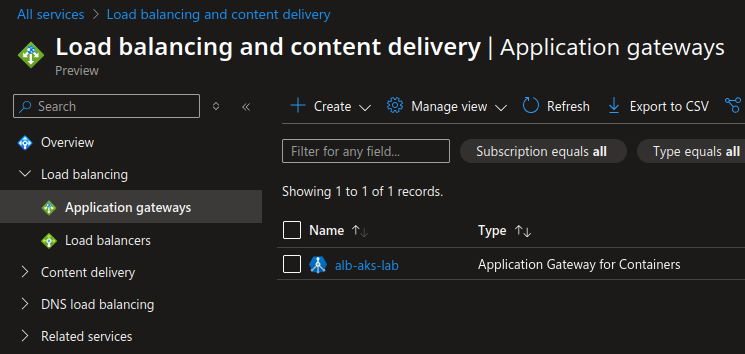
The fun’s only get started, because the az cli command to list application gateway WILL NOT list the agc as an application gateway (which make sense IMHO)
df@df-2404lts:~$ az network application-gateway list
[]
there’s in fact a dedicated resource in the az cli for agc, or specifically one of its Azure components.
df@df-2404lts:~$ az network alb list | jq .[]
{
"associations": [
{
"id": "/subscriptions/00000000-0000-0000-0000-000000000000/resourceGroups/rsg-spoke-agw/providers/Microsoft.ServiceNetworking/trafficControllers/alb-aks-lab/associations/AlbSubnetAssociation",
"resourceGroup": "rsg-spoke-agw"
}
],
"configurationEndpoints": [
"ae0b5824c789458b89f76f38055e34e2.alb.azure.com"
],
"frontends": [
{
"id": "/subscriptions/00000000-0000-0000-0000-000000000000/resourceGroups/rsg-spoke-agw/providers/Microsoft.ServiceNetworking/trafficControllers/alb-aks-lab/frontends/albfe-aks-lab",
"resourceGroup": "rsg-spoke-agw"
}
],
"id": "/subscriptions/00000000-0000-0000-0000-000000000000/resourceGroups/rsg-spoke-agw/providers/Microsoft.ServiceNetworking/trafficControllers/alb-aks-lab",
"location": "francecentral",
"name": "alb-aks-lab",
"provisioningState": "Succeeded",
"resourceGroup": "rsg-spoke-agw",
"securityPolicies": [],
"systemData": {
"createdAt": "2025-09-16T08:34:06.3189045Z",
"createdBy": "00000000-0000-0000-0000-000000000000",
"createdByType": "Application",
"lastModifiedAt": "2025-09-16T08:34:06.3189045Z",
"lastModifiedBy": "00000000-0000-0000-0000-000000000000",
"lastModifiedByType": "Application"
},
"type": "Microsoft.ServiceNetworking/TrafficControllers"
}
So, kind of an Application Gateway but not really.
Ok, let’s have a look at the components, as decribed in the documentation.
AGC is organized with a hierearchy in mind, and also with a duality of control planes.
About the control planes, we have resources in Azure, hence our first control plane being Azure, and additional resources in the Kubernetes cluster for management with the kubernetes API, and thus our second control plane being K8S.
On the Azure side, we get first the parent resource, the said Application Gateway for Containers. Looking into this resource, we can find 3 child resources:
The frontend resource is what is available from a user standpoint. Thus it comes with an fqdn which is supposed to be associated to a CNAME record in a custom DNS. there can be more than one frontend for one AGC. The network association connect the front end to an Azure subnet, which should be accessible from the AKS cluster. There is a limit of 1 association per AGC. Last, the security policy allows to map a WAF policy to the Application Gateway for Controller instance.
On the Kubernetes side, we have the ALB controller, which, as its name implies, controls the Application Gateway for Containers resources. It comes under the form of pods, managed in a deployment, and deployed currently through an Helm Chart. There is no, at this date, AKS add-on to simplify/automate all this deployment, as is the case with its predecessor the Application Gateway Ingress Controller. And we will see that it makes our life a bit harder, depending on how you happen to deploy your AGC.
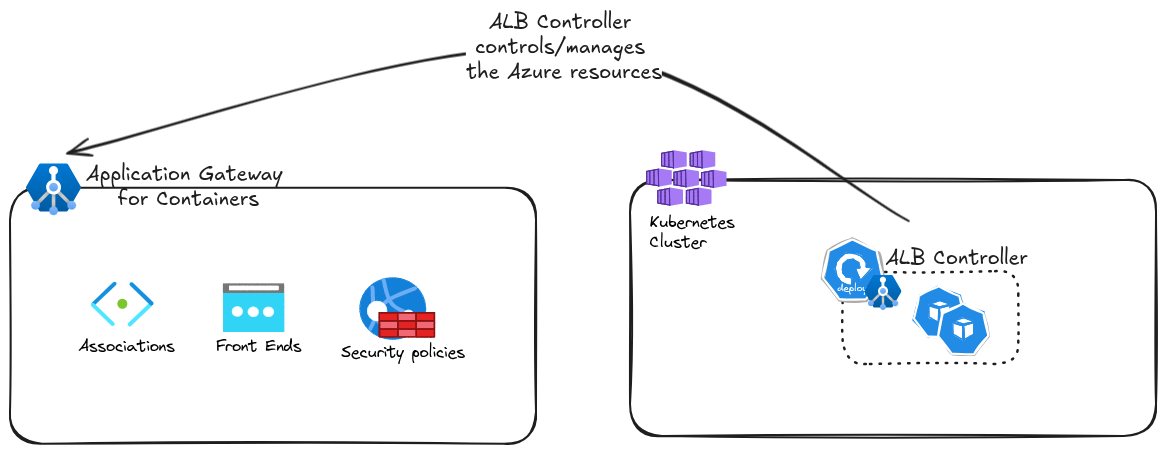
The ALB controller may manage everything, or not, depending on the deployment model chosen. There are 2 models available:
- The Application Gateway for Containers - managed by ALB controller, which means that we deploy the ALB controller in a Kubernetes cluster, and it will manage all the Azure plane resources that we mentionned earlier.
- The Application Gateway for Containers - Bring Your Own Deployment, for which the Azure resources are deployed beforehand, and the ALB controller takes controls after its deployment.
So that’s about all for architecture concepts. Let’s move on to prerequisites and a sandbox deployment.
2. Prerequisites and deployment on an AKS cluster
2.1. Prerequisites
In terms of prerequisites, we have a bunch of things to think about.
First, it may be obvious, but we need the following providers to be registered on the subscription:
Microsoft.ContainerServiceMicrosoft.NetworkMicrosoft.NetworkFunctionMicrosoft.ServiceNetworking
df@df-2404lts:~$ az provider show -n Microsoft.ContainerService | jq .registrationState
"Registered"
df@df-2404lts:~$ az provider show -n Microsoft.Network | jq .registrationState
"Registered"
df@df-2404lts:~$ az provider show -n Microsoft.NetworkFunction | jq .registrationState
"Registered"
df@df-2404lts:~$ az provider show -n Microsoft.ServiceNetworking | jq .registrationState
"Registered"
To interact with the Application Gateway For containers through az cli, we would also need to add the alb extension through the az extension add command.
So that was the easy part.
Now, about the AKS cluster, Azure CNI or Azure CNI OVerlay is supported. So no BYOCNI in this case, but that’s all right. We also need to have the OIDC provider enabled, because the ALB controller works with Azure Workload Identity.
And that means that we need an Azure managed Identity with federated credentials to make the controller works. Depending on the deployment model, and also the underlying network configuration, this user assigned identity may need access on different scopes.
For a fully managed deployment, the ALB controller creates and manages the ressources in the Azure plane, and by default, those resources (well, only the alb in fact, because the others resources are child resources, remember? 🤓) are added in the AKS managed resource group.
So it make sense that in this case, we need to scope authorization on this resource group.
To interact with the AGC Azure resources, the identity needs a specific role called AppGw for Containers Configuration Manager. This role includes specific authorizations in the data plane.
{
"id": "/providers/Microsoft.Authorization/roleDefinitions/fbc52c3f-28ad-4303-a892-8a056630b8f1",
"properties": {
"roleName": "AppGw for Containers Configuration Manager",
"description": "Allows access and configuration updates to Application Gateway for Containers resource.",
"assignableScopes": [
"/"
],
"permissions": [
{
"actions": [
"Microsoft.ServiceNetworking/trafficControllers/read",
"Microsoft.ServiceNetworking/trafficControllers/write",
"Microsoft.ServiceNetworking/trafficControllers/delete",
"Microsoft.ServiceNetworking/trafficControllers/frontends/read",
"Microsoft.ServiceNetworking/trafficControllers/frontends/write",
"Microsoft.ServiceNetworking/trafficControllers/frontends/delete",
"Microsoft.ServiceNetworking/trafficControllers/associations/read",
"Microsoft.ServiceNetworking/trafficControllers/associations/write",
"Microsoft.ServiceNetworking/trafficControllers/associations/delete",
"Microsoft.ServiceNetworking/trafficControllers/*/read",
"Microsoft.ServiceNetworking/trafficControllers/*/write",
"Microsoft.ServiceNetworking/trafficControllers/*/delete",
"Microsoft.Resources/subscriptions/resourcegroups/deployments/read",
"Microsoft.Resources/subscriptions/resourcegroups/deployments/write",
"Microsoft.Resources/subscriptions/resourcegroups/deployments/operations/read",
"Microsoft.Resources/subscriptions/resourcegroups/deployments/operationstatuses/read"
],
"notActions": [],
"dataActions": [
"Microsoft.ServiceNetworking/trafficControllers/serviceRoutingConfigurations/read",
"Microsoft.ServiceNetworking/trafficControllers/serviceRoutingConfigurations/write",
"Microsoft.ServiceNetworking/trafficControllers/serviceRoutingConfigurations/delete"
],
"notDataActions": []
}
]
}
}
For a Bring Your Own Deployment, the same authorizations are required, but chances are that the Azure resources do not live in the AKS managed RG, so the target scope should be identified clearly before hand. Also, because the managed identity still needs to be able to at least read what happens to the AKS Azure resources, a Reader role is still required on the AKS managed RG.
Now, another very important point is the underlying network.
As discussed, the association resource point to an Azure subnet, which means that the said subnet should be manageable from the identity. Thus a Network Contributor role may be required (or a more granular custom role if desired). And we did not discussed this before, but the subnet is delegated to Microsoft.ServiceNetworking/trafficControllers.
Last about the subnet, a /24 is the minimal size acceptable.
There are others specificities but we meet them along the way. Let’s get to the deployment.
2.2. Deployment of Azure resources
We will deploy AGC in an AKS Cluster with Azure CNI Overlay. To keep things simple, we’ll deploy everything in a unique subnet.
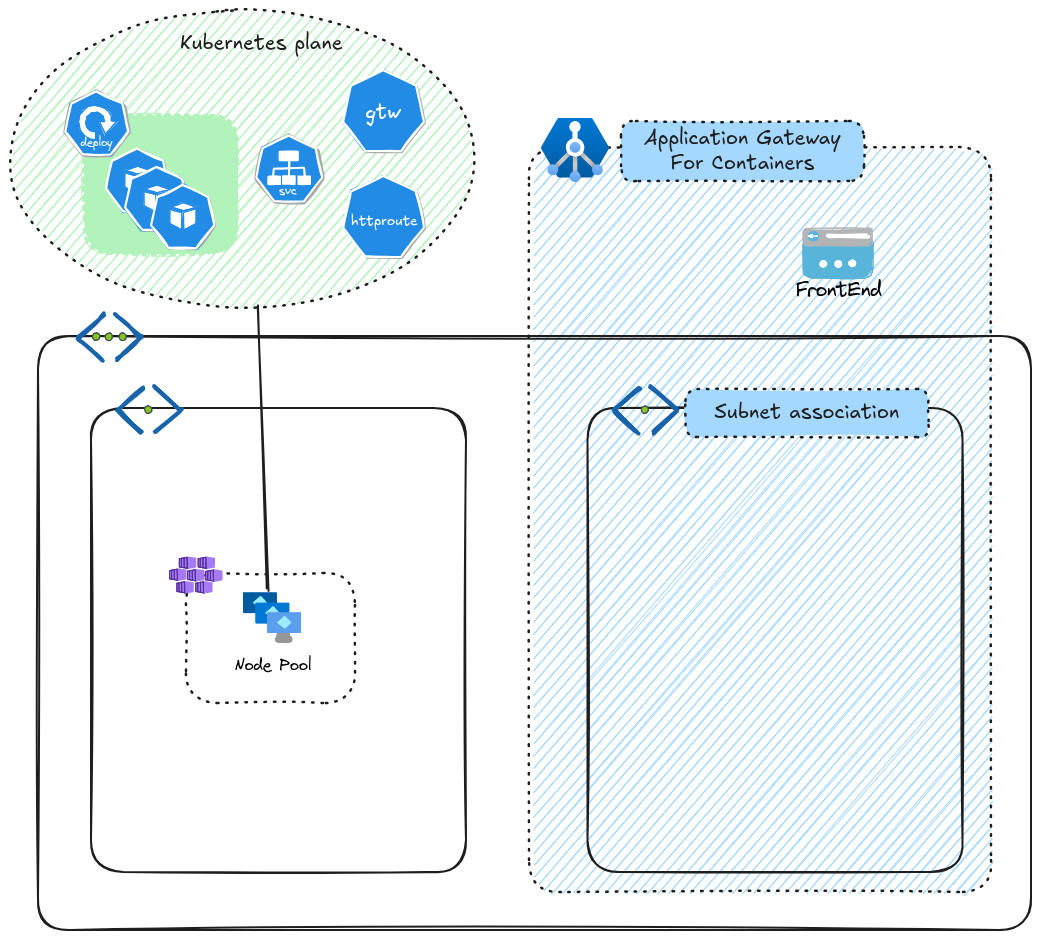
Deploying AGC as a bring your own deployment requires to create the Azure plane resources. The parent resource is an Azure Application Load Balancer.
resource "azurerm_application_load_balancer" "Alb" {
name = "alb-aks-lab"
resource_group_name = azurerm_resource_group.RGVnet["agw"].name
location = azurerm_resource_group.RGVnet["agw"].location
}
And the following resources are:
- A Frontend
resource "azurerm_application_load_balancer_frontend" "AlbFe" {
name = "albfe-aks-lab"
application_load_balancer_id = azurerm_application_load_balancer.Alb.id
}
- And a subnet association
resource "azurerm_application_load_balancer_subnet_association" "AlbSubnetAssociation" {
name = "AlbSubnetAssociation"
application_load_balancer_id = azurerm_application_load_balancer.Alb.id
subnet_id = "${module.vnet["aks"].VNetFullOutput.id}/subnets/AlbSubnetbyo"
}
The association points to a subnet created before hand, with delegation configured to traffic controllers.
df@df-2404lts:~$ az network vnet subnet show -n AlbSubnetbyo --vnet-name vnet-sbx-aks1 -g rsg-spoke-aks
{
"addressPrefix": "172.16.13.0/24",
"defaultOutboundAccess": true,
"delegations": [
{
"actions": [
"Microsoft.Network/virtualNetworks/subnets/join/action"
],
"etag": "W/\"98902553-60ab-4fe9-9fbb-cc8d09e88575\"",
"id": "/subscriptions/00000000-0000-0000-0000-000000000000/resourceGroups/rsg-spoke-aks/providers/Microsoft.Network/virtualNetworks/vnet-sbx-aks1/subnets/AlbSubnetbyo/delegations/AlbDelegation",
"name": "AlbDelegation",
"provisioningState": "Succeeded",
"resourceGroup": "rsg-spoke-aks",
"serviceName": "Microsoft.ServiceNetworking/trafficControllers",
"type": "Microsoft.Network/virtualNetworks/subnets/delegations"
}
],
"etag": "W/\"98902553-60ab-4fe9-9fbb-cc8d09e88575\"",
"id": "/subscriptions/00000000-0000-0000-0000-000000000000/resourceGroups/rsg-spoke-aks/providers/Microsoft.Network/virtualNetworks/vnet-sbx-aks1/subnets/AlbSubnetbyo",
"name": "AlbSubnetbyo",
"privateEndpointNetworkPolicies": "Disabled",
"privateLinkServiceNetworkPolicies": "Enabled",
"provisioningState": "Succeeded",
"resourceGroup": "rsg-spoke-aks",
"serviceEndpoints": [],
"type": "Microsoft.Network/virtualNetworks/subnets"
}
Last but not least, we must prepare the managed identity and its federated credentials
df@df-2404lts:~$ az identity list |jq .[0]
{
"clientId": "00000000-0000-0000-0000-000000000000",
"id": "/subscriptions/00000000-0000-0000-0000-000000000000/resourcegroups/rsg-spoke-agw/providers/Microsoft.ManagedIdentity/userAssignedIdentities/azure-alb-identity",
"location": "francecentral",
"name": "azure-alb-identity",
"principalId": "00000000-0000-0000-0000-000000000000",
"resourceGroup": "rsg-spoke-agw",
"systemData": null,
"tags": {},
"tenantId": "00000000-0000-0000-0000-000000000000",
"type": "Microsoft.ManagedIdentity/userAssignedIdentities"
}
df@df-2404lts:~$ az identity federated-credential list --identity-name azure-alb-identity -g rsg-spoke-agw |jq .
[
{
"audiences": [
"api://AzureADTokenExchange"
],
"id": "/subscriptions/00000000-0000-0000-0000-000000000000/resourcegroups/rsg-spoke-agw/providers/Microsoft.ManagedIdentity/userAssignedIdentities/azure-alb-identity/federatedIdentityCredentials/azure-alb-identity",
"issuer": "https://francecentral.oic.prod-aks.azure.com/00000000-0000-0000-0000-000000000000/00000000-0000-0000-0000-000000000000/",
"name": "azure-alb-identity",
"resourceGroup": "rsg-spoke-agw",
"subject": "system:serviceaccount:azure-alb-system:alb-controller-sa",
"type": "Microsoft.ManagedIdentity/userAssignedIdentities/federatedIdentityCredentials"
}
]

Last, something that should not be missed, the federated credential name must be azure-alb-identity
In case of the managed deployment, we only need the subnet, and the proper configuration on the identity. The application load balancer is created from the Kubernetes plane. We’ll see this in the following section.
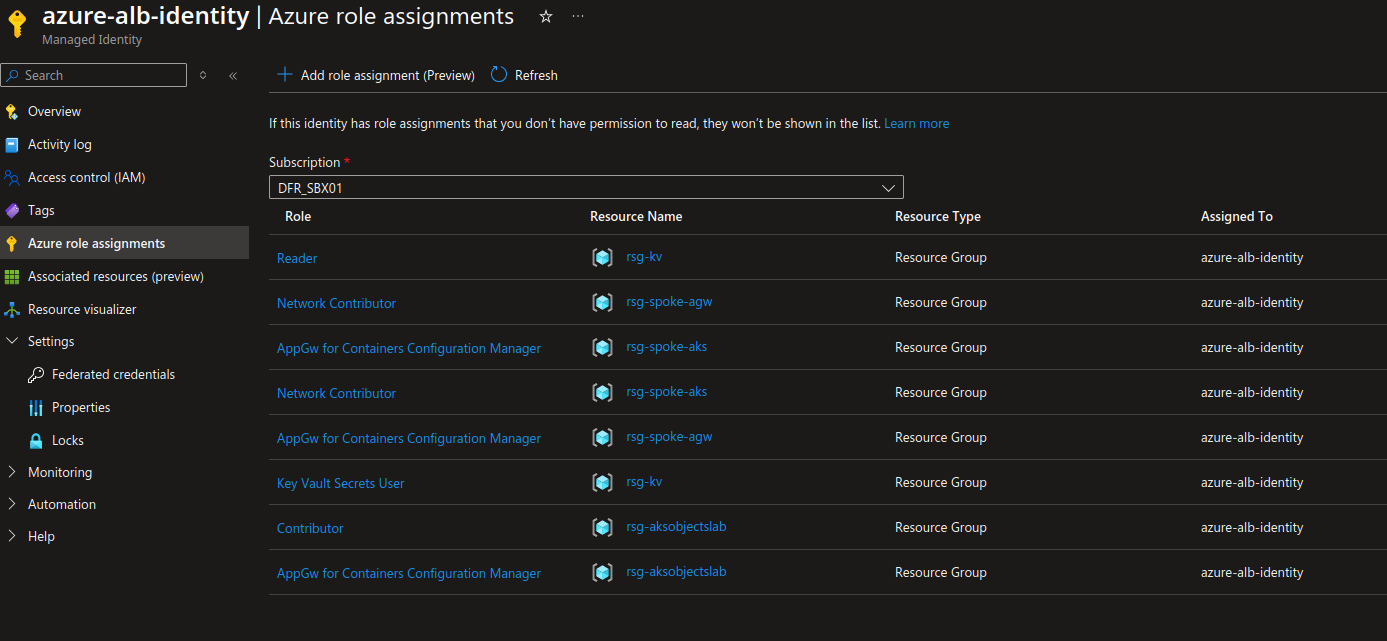
2.3. Deployment of the ALB controller
Once the Azure resources are available with the AKS cluster, we can take care of the ALB controller.
As discussed earlier, it is currently installed through an helm chart, with information available on the Azure documentation, but also on the [artifacthub.io]. We need to uri of the chart, and a few parameters, specifically one being the reference to the managed identity created before, since ALB controller uses workload identity to interact with.
#!/bin/bash
echo "pulling the alb-controller helm chart from the microsoft container registry"
helm pull oci://mcr.microsoft.com/application-lb/charts/alb-controller --untar --untardir ./localhelmcharts --version 1.7.9
echo "removing the values.schema.json file which is currently causing problems with helm install"
rm ./localhelmcharts/alb-controller/values.schema.json
echo "Installing chart from local path"
helm upgrade alb-controller ./localhelmcharts/alb-controller --version 1.7.9 --namespace "azure-alb-system" --create-namespace --set albController.namespace="azure-alb-system" --set albController.podIdentity.clientId="<client_id_of_the_managed_identity>" --install
Notice that we download the chart and install from a local path. We’ll discuss the why of this, among other things, later. We should get something similar if the installation is sucessful.
df@df-2404lts:~/Documents$ helm upgrade alb-controller ./localhelmcharts/alb-controller --version 1.7.9 --namespace "azure-alb-system" --create-namespace --set albController.namespace="azure-alb-system" --set albController.podIdentity.clientId="00000000-0000-0000-0000-000000000000" --install
Release "alb-controller" does not exist. Installing it now.
NAME: alb-controller
LAST DEPLOYED: Fri Sep 26 12:07:10 2025
NAMESPACE: azure-alb-system
STATUS: deployed
REVISION: 1
TEST SUITE: None
NOTES:
Congratulations! The ALB Controller has been installed in your Kubernetes cluster!
And find a deployment, along with a service account inside the azure-alb-system
f@df-2404lts:~$ k get deployments.apps -n azure-alb-system alb-controller
NAME READY UP-TO-DATE AVAILABLE AGE
alb-controller 2/2 2 2 4h10m
f@df-2404lts:~$ k get sa -n azure-alb-system
NAME SECRETS AGE
alb-controller-sa 0 4h10m
default 0 4h10m
checking the logs for error helps us to validate that everything is as expected.
f@df-2404lts:~$ k logs -n azure-alb-system deployments/alb-controller > alblog.json
Found 2 pods, using pod/alb-controller-86d7bc7694-nl8gt
Defaulted container "alb-controller" out of: alb-controller, init-alb-controller-crds (init), init-alb-controller-bootstrap (init)
{"level":"info","version":"1.7.9","Timestamp":"2025-09-25T13:05:19.799583379Z","message":"Starting alb-controller"}
{"level":"info","version":"1.7.9","Timestamp":"2025-09-25T13:05:19.803113126Z","message":"Starting alb-controller version 1.7.9"}
{"level":"info","version":"1.7.9","Timestamp":"2025-09-25T13:05:19.944422518Z","message":"attempting to acquire leader lease azure-alb-system/alb-controller-leader-election..."}
{"level":"info","version":"1.7.9","Timestamp":"2025-09-25T13:05:22.889427539Z","message":"successfully acquired lease azure-alb-system/alb-controller-leader-election"}
{"level":"info","version":"1.7.9","name":"events","type":"Normal","object":{"kind":"Lease","namespace":"azure-alb-system","name":"alb-controller-leader-election","uid":"5ef1a476-c87c-46ce-a8a7-614f565ddc16","apiVersion":"coordination.k8s.io/v1","resourceVersion":"8939"},"reason":"LeaderElection","Timestamp":"2025-09-25T13:05:22.889774344Z","message":"alb-controller-86d7bc7694-nl8gt_e09b6ac8-e506-4e90-81c2-8a5f11a04300 became leader"}
{"level":"info","version":"1.7.9","controller":"lb-resources-reconciler","source":"kind source: *v1.Secret","Timestamp":"2025-09-25T13:05:22.890184549Z","message":"Starting EventSource"}
{"level":"info","version":"1.7.9","controller":"lb-resources-reconciler","source":"kind source: *v1.FrontendTLSPolicy","Timestamp":"2025-09-25T13:05:22.890394152Z","message":"Starting EventSource"}
{"level":"info","version":"1.7.9","controller":"lb-resources-reconciler","source":"kind source: *v1.IngressClass","Timestamp":"2025-09-25T13:05:22.890529254Z","message":"Starting EventSource"}
{"level":"info","version":"1.7.9","controller":"lb-resources-reconciler","source":"kind source: *v1.Ingress","Timestamp":"2025-09-25T13:05:22.890630155Z","message":"Starting EventSource"}
{"level":"info","version":"1.7.9","controller":"lb-resources-reconciler","source":"kind source: *v1.IngressExtension","Timestamp":"2025-09-25T13:05:22.890660455Z","message":"Starting EventSource"}
{"level":"info","version":"1.7.9","controller":"lb-resources-reconciler","source":"kind source: *v1.Service","Timestamp":"2025-09-25T13:05:22.890718856Z","message":"Starting EventSource"}
Ok, let’s admit that we live in a perfect world and everything went smoothly. Again, more on that in a dedicated part 😅
Let’s try to actually expose apps.
3. Managing Gateway and HTTP routes with AGC
3.1. Using AGC Bring Your Own Deployment
To expose an app with the Gateway API, we need a Gateway, an Http route and then we reach the apps.
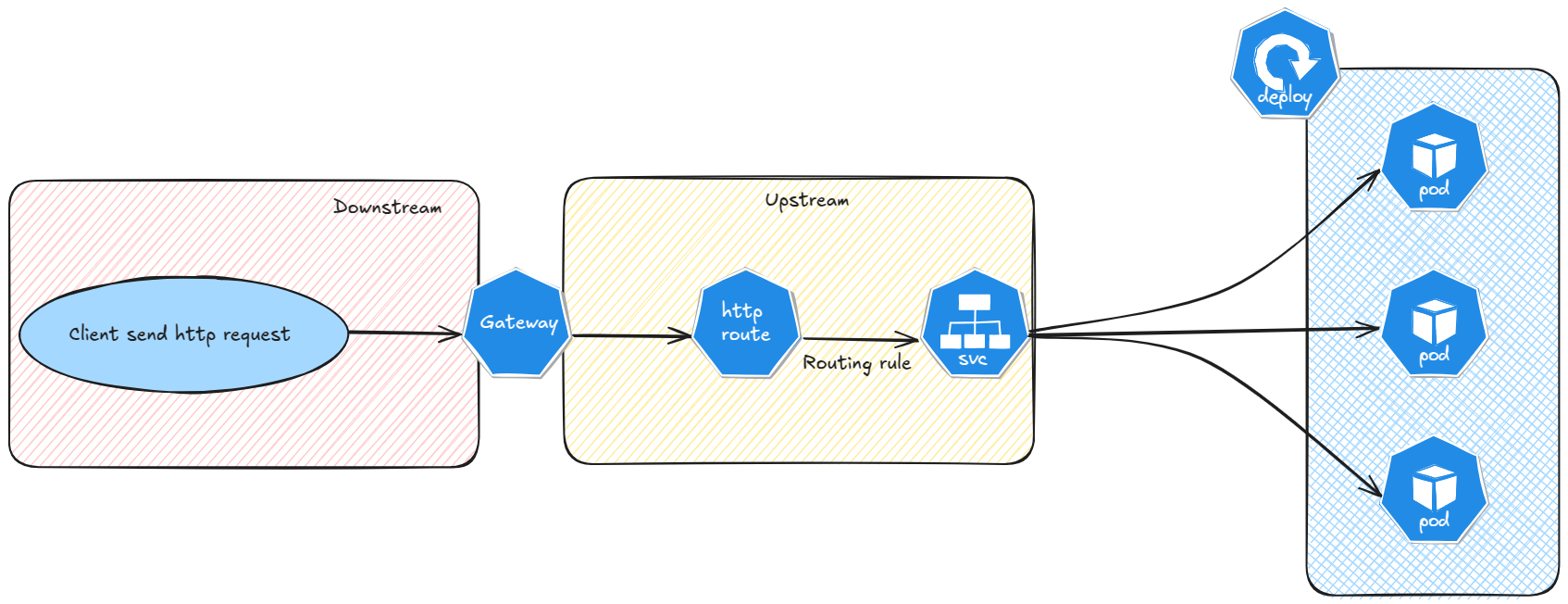
If we have 2 demo apps as below.
apiVersion: v1
kind: ConfigMap
metadata:
name: index-html-configmap1
namespace: agctest
data:
index.html: |
<html>
<h1>Welcome to Demo App 1</h1>
</br>
<h2>This is a demo to illustrate Gateway API </h2>
<img src="https://riseofgunpla.com/wp-content/uploads/2024/12/In-ERA-Lizard-9.jpg" />
</html
---
apiVersion: apps/v1
kind: Deployment
metadata:
labels:
app: demoapp1
name: demoapp1
namespace: agctest
spec:
replicas: 3
selector:
matchLabels:
app: demoapp1
template:
metadata:
labels:
app: demoapp1
spec:
volumes:
- name: nginx-index-file
configMap:
name: index-html-configmap1
containers:
- image: nginx
name: nginx
volumeMounts:
- name: nginx-index-file
mountPath: /usr/share/nginx/html
---
apiVersion: v1
kind: Service
metadata:
name: demosvcapp1
namespace: agctest
annotations:
service.cilium.io/global: "true"
service.cilium.io/shared: "true"
spec:
type: ClusterIP
ports:
- port: 8080
targetPort: 80
protocol: TCP
selector:
app: demoapp1
---
apiVersion: apps/v1
kind: Deployment
metadata:
creationTimestamp: null
labels:
app: client1
name: client1
namespace: agctest
spec:
replicas: 3
selector:
matchLabels:
app: client1
strategy: {}
template:
metadata:
creationTimestamp: null
labels:
app: client1
spec:
containers:
- image: nginx
name: nginx
resources: {}
status: {}
---
apiVersion: v1
kind: ConfigMap
metadata:
name: index-html-configmap2
namespace: agctest
data:
index.html: |
<html>
<h1>Welcome to Demo App 2</h1>
</br>
<h2>This is a demo to illustrate Gateway API </h2>
<img src="https://riseofgunpla.com/wp-content/uploads/2020/07/GUN83120_9.jpg" />
</html
---
apiVersion: apps/v1
kind: Deployment
metadata:
labels:
app: demoapp2
name: demoapp2
namespace: agctest
spec:
replicas: 3
selector:
matchLabels:
app: demoapp2
template:
metadata:
labels:
app: demoapp2
spec:
volumes:
- name: nginx-index-file
configMap:
name: index-html-configmap2
containers:
- image: nginx
name: nginx
volumeMounts:
- name: nginx-index-file
mountPath: /usr/share/nginx/html
---
apiVersion: v1
kind: Service
metadata:
name: demosvcapp2
namespace: agctest
annotations:
service.cilium.io/global: "true"
service.cilium.io/shared: "true"
spec:
type: ClusterIP
ports:
- port: 8090
targetPort: 80
protocol: TCP
selector:
app: demoapp2
We can then create a Gateway. But before we check the GatewayClass.
df@df-2404lts:~$ k get gatewayclasses.gateway.networking.k8s.io
NAME CONTROLLER ACCEPTED AGE
azure-alb-external alb.networking.azure.io/alb-controller True 4h24m
The Gateway definition is like this:
apiVersion: gateway.networking.k8s.io/v1beta1
kind: Gateway
metadata:
name: gateway-03
namespace: agctest
annotations:
alb.networking.azure.io/alb-id: /subscriptions/00000000-0000-0000-0000-000000000000/resourceGroups/rsg-spoke-aks/providers/Microsoft.ServiceNetworking/trafficControllers/alb-aks-lab2
spec:
gatewayClassName: azure-alb-external
listeners:
- name: http-listener
port: 80
protocol: HTTP
allowedRoutes:
namespaces:
from: All
addresses:
- type: alb.networking.azure.io/alb-frontend
value: albfe-aks-lab2
You may notice the from all namespaces configuration, which allows us to have Http routes from all namespaces associate to this Gateway.
You should also notice the addresses section, with its type specific to AGC and set to the front end that we created earlier.
Also, the annotation alb.networking.azure.io/alb-id which references the alb created in the Azure plane.
df@df-2404lts:~$ az network alb frontend list --alb-name alb-aks-lab2 -g rsg-spoke-aks
[
{
"fqdn": "esf3fzdegnfwacgb.fz50.alb.azure.com",
"id": "/subscriptions/00000000-0000-0000-0000-000000000000/resourceGroups/rsg-spoke-aks/providers/Microsoft.ServiceNetworking/trafficControllers/alb-aks-lab2/frontends/albfe-aks-lab2",
"location": "francecentral",
"name": "albfe-aks-lab2",
"provisioningState": "Succeeded",
"resourceGroup": "rsg-spoke-aks",
"systemData": {
"createdAt": "2025-09-25T13:47:27.3116839Z",
"createdBy": "00000000-0000-0000-0000-000000000000",
"createdByType": "Application",
"lastModifiedAt": "2025-09-25T13:47:27.3116839Z",
"lastModifiedBy": "00000000-0000-0000-0000-000000000000",
"lastModifiedByType": "Application"
},
"tags": {},
"type": "Microsoft.ServiceNetworking/TrafficControllers/Frontends"
}
]
If the Gateway is working correctly, we should have an Accepted status, and we should find in the addresses section a Hostname type with an fqdn ending with alb.azure.com
df@df-2404lts:~$ k get gateway -n agctest gateway-03 -o json | jq .status
{
"addresses": [
{
"type": "Hostname",
"value": "esf3fzdegnfwacgb.fz50.alb.azure.com"
}
],
"conditions": [
{
"lastTransitionTime": "2025-09-25T14:23:27Z",
"message": "Valid Gateway",
"observedGeneration": 1,
"reason": "Accepted",
"status": "True",
"type": "Accepted"
},
{
"lastTransitionTime": "2025-09-25T14:23:27Z",
"message": "Application Gateway for Containers resource has been successfully updated.",
"observedGeneration": 1,
"reason": "Programmed",
"status": "True",
"type": "Programmed"
}
],
"listeners": [
{
"attachedRoutes": 1,
"conditions": [
{
"lastTransitionTime": "2025-09-25T14:23:27Z",
"message": "",
"observedGeneration": 1,
"reason": "ResolvedRefs",
"status": "True",
"type": "ResolvedRefs"
},
{
"lastTransitionTime": "2025-09-25T14:23:27Z",
"message": "Listener is Accepted",
"observedGeneration": 1,
"reason": "Accepted",
"status": "True",
"type": "Accepted"
},
{
"lastTransitionTime": "2025-09-25T14:23:27Z",
"message": "Application Gateway for Containers resource has been successfully updated.",
"observedGeneration": 1,
"reason": "Programmed",
"status": "True",
"type": "Programmed"
}
],
"name": "http-listener",
"supportedKinds": [
{
"group": "gateway.networking.k8s.io",
"kind": "HTTPRoute"
},
{
"group": "gateway.networking.k8s.io",
"kind": "GRPCRoute"
}
]
}
]
}
We can now create an Http route to expose our demo app, as below.
apiVersion: gateway.networking.k8s.io/v1
kind: HTTPRoute
metadata:
name: demo-httproute2
namespace: agctest
spec:
parentRefs:
- name: gateway-03
rules:
- backendRefs:
- name: demosvcapp1
port: 8080
kind: Service
- backendRefs:
- name: demosvcapp2
port: 8090
kind: Service
matches:
- path:
type: PathPrefix
value: /test
filters:
- type: URLRewrite
urlRewrite:
path:
type: ReplacePrefixMatch
replacePrefixMatch: /
If we try to reach the host on / or /test, we should get our application.
df@df-2404lts:~$ curl -i -X GET esf3fzdegnfwacgb.fz50.alb.azure.com
HTTP/1.1 200 OK
server: Microsoft-Azure-Application-LB/AGC
date: Thu, 25 Sep 2025 17:36:43 GMT
content-type: text/html
content-length: 188
last-modified: Thu, 25 Sep 2025 13:00:23 GMT
etag: "68d53ce7-bc"
accept-ranges: bytes
<html>
<h1>Welcome to Demo App 1</h1>
</br>
<h2>This is a demo to illustrate Gateway API </h2>
<img src="https://riseofgunpla.com/wp-content/uploads/2024/12/In-ERA-Lizard-9.jpg" />
</html
df@df-2404lts:~$ curl -i -X GET esf3fzdegnfwacgb.fz50.alb.azure.com/test
HTTP/1.1 200 OK
server: Microsoft-Azure-Application-LB/AGC
date: Thu, 25 Sep 2025 17:36:46 GMT
content-type: text/html
content-length: 183
last-modified: Thu, 25 Sep 2025 13:00:27 GMT
etag: "68d53ceb-b7"
accept-ranges: bytes
<html>
<h1>Welcome to Demo App 2</h1>
</br>
<h2>This is a demo to illustrate Gateway API </h2>
<img src="https://riseofgunpla.com/wp-content/uploads/2020/07/GUN83120_9.jpg" />
</html
Ok, so that’s that, now what about the managed deployment?
3.2. Using AGC with the managed deployment.
As we said earlier, we do not really interact with the Azure plane in this scenario.
We do however need a delegated subnet, on which the azure alb identity mush have access.
For this scenario, we switch to an Azure CNI Pod subnet cluster, instead of an Azure CNI overlay cluster. To keep it short, it’s not working as expected betweenb Azure CNI Overlay and the managed AGC deployment.
df@df-2404lts:~$ az network vnet list -o table
Name ResourceGroup Location NumSubnets Prefixes DnsServers DDOSProtection VMProtection
------------- --------------- ------------- ------------ ------------- ------------ ---------------- --------------
vnet-sbx-agw1 rsg-spoke-agw francecentral 2 172.21.4.0/23 False
vnet-sbx-aks1 rsg-spoke-aks francecentral 7 172.16.0.0/16 False
df@df-2404lts:~$ az network vnet subnet list --vnet-name vnet-sbx-agw1 -g rsg-spoke-agw -o table
AddressPrefix DefaultOutboundAccess Name PrivateEndpointNetworkPolicies PrivateLinkServiceNetworkPolicies ProvisioningState ResourceGroup
--------------- ----------------------- ------------------ -------------------------------- ----------------------------------- ------------------- ---------------
172.21.4.0/24 True sub1-vnet-sbx-agw1 Disabled Enabled Succeeded rsg-spoke-agw
172.21.5.0/24 True sub2-vnet-sbx-agw1 Disabled Enabled Succeeded rsg-spoke-agw
df@df-2404lts:~$ az network vnet subnet list --vnet-name vnet-sbx-agw1 -g rsg-spoke-agw -o json |jq .[1]
{
"addressPrefix": "172.21.5.0/24",
"defaultOutboundAccess": true,
"delegations": [
{
"actions": [
"Microsoft.Network/virtualNetworks/subnets/join/action"
],
"etag": "W/\"95a80019-2123-49be-88f0-be8e1bf72ee5\"",
"id": "/subscriptions/00000000-0000-0000-0000-000000000000/resourceGroups/rsg-spoke-agw/providers/Microsoft.Network/virtualNetworks/vnet-sbx-agw1/subnets/sub2-vnet-sbx-agw1/delegations/AlbDelegation",
"name": "AlbDelegation",
"provisioningState": "Succeeded",
"resourceGroup": "rsg-spoke-agw",
"serviceName": "Microsoft.ServiceNetworking/trafficControllers",
"type": "Microsoft.Network/virtualNetworks/subnets/delegations"
}
],
"etag": "W/\"95a80019-2123-49be-88f0-be8e1bf72ee5\"",
"id": "/subscriptions/00000000-0000-0000-0000-000000000000/resourceGroups/rsg-spoke-agw/providers/Microsoft.Network/virtualNetworks/vnet-sbx-agw1/subnets/sub2-vnet-sbx-agw1",
"name": "sub2-vnet-sbx-agw1",
"privateEndpointNetworkPolicies": "Disabled",
"privateLinkServiceNetworkPolicies": "Enabled",
"provisioningState": "Succeeded",
"resourceGroup": "rsg-spoke-agw",
"serviceEndpoints": [],
"type": "Microsoft.Network/virtualNetworks/subnets"
}
Instead of creating the ALB from the Azure plane, we use a specific crd related to AGC.
df@df-2404lts:~$ k get crd |grep alb.networking.azure.io
applicationloadbalancer.alb.networking.azure.io 2025-09-25T13:01:13Z
backendloadbalancingpolicy.alb.networking.azure.io 2025-09-25T13:01:13Z
backendtlspolicies.alb.networking.azure.io 2025-09-25T13:01:13Z
frontendtlspolicies.alb.networking.azure.io 2025-09-25T13:01:13Z
healthcheckpolicy.alb.networking.azure.io 2025-09-25T13:01:13Z
ingressextension.alb.networking.azure.io 2025-09-25T13:01:13Z
routepolicies.alb.networking.azure.io 2025-09-25T13:01:13Z
webapplicationfirewallpolicy.alb.networking.azure.io 2025-09-25T13:01:16Z
The one we are interested in is the applicationloadbalancer.alb.networking.azure.io, with a configuration like this.
apiVersion: alb.networking.azure.io/v1
kind: ApplicationLoadBalancer
metadata:
name: alb-test2
namespace: agcmanaged
spec:
associations:
- /subscriptions/00000000-0000-0000-0000-00000000000/resourceGroups/rsg-spoke-aks/providers/Microsoft.Network/virtualNetworks/vnet-sbx-aks1/subnets/AlbSubnetmanaged
In this case, we kind of create the association ourselve with the spec.associations parameter, for which we specify the subnet shown earlier.
We can check the status of the ALB.
df@df-2404lts:~$ k get applicationloadbalancer.alb.networking.azure.io -n agcmanaged alb-test -o json|jq .status
{
"conditions": [
{
"lastTransitionTime": "2025-09-26T14:06:15Z",
"message": "Valid Application Gateway for Containers resource",
"observedGeneration": 1,
"reason": "Accepted",
"status": "True",
"type": "Accepted"
},
{
"lastTransitionTime": "2025-09-26T14:06:15Z",
"message": "alb-id=/subscriptions/00000000-0000-0000-0000-000000000000/resourceGroups/rsg-aksobjectslab/providers/Microsoft.ServiceNetworking/trafficControllers/alb-b4577b87",
"observedGeneration": 1,
"reason": "Ready",
"status": "True",
"type": "Deployment"
}
]
}
And the alb controller logs.
df@df-2404lts:~$ k logs -n azure-alb-system deployments/alb-controller |grep alb-test
Found 2 pods, using pod/alb-controller-55884bcd8b-kh9n7
Defaulted container "alb-controller" out of: alb-controller, init-alb-controller-crds (init), init-alb-controller-bootstrap (init)
{"level":"info","version":"1.7.9","controller":"lb-resources-reconciler","object":{"name":"alb-test","namespace":"agcmanaged"},"namespace":"agcmanaged","name":"alb-test","reconcileID":"4a30cb50-1c81-4692-b908-6ebefc96f404","Timestamp":"2025-09-26T14:01:52.688314105Z","message":"Reconciling"}
{"level":"info","version":"1.7.9","Timestamp":"2025-09-26T14:01:52.688333806Z","message":"Received request for object agcmanaged/alb-test"}
{"level":"info","version":"1.7.9","controller":"lb-resources-reconciler","object":{"name":"alb-test","namespace":"agcmanaged"},"namespace":"agcmanaged","name":"alb-test","reconcileID":"4a30cb50-1c81-4692-b908-6ebefc96f404","Timestamp":"2025-09-26T14:01:52.688343306Z","message":"Reconcile successful"}
{"level":"info","version":"1.7.9","Timestamp":"2025-09-26T14:01:52.688356606Z","message":"Processing requested object agcmanaged/alb-test"}
{"level":"info","version":"1.7.9","Timestamp":"2025-09-26T14:01:52.688664611Z","message":"Successfully processed object agcmanaged/alb-test"}
{"level":"info","version":"1.7.9","operationID":"5a123591-abf9-4dba-b9f1-fe291e672f0d","Timestamp":"2025-09-26T14:01:52.688679811Z","message":"Starting event handler for Application Gateway for Containers resource agcmanaged/alb-test"}
{"level":"info","version":"1.7.9","AGC":"agcmanaged/alb-test","operationID":"5a123591-abf9-4dba-b9f1-fe291e672f0d","operationID":"5a123591-abf9-4dba-b9f1-fe291e672f0d","Timestamp":"2025-09-26T14:01:52.688687011Z","message":"Creating new Application Gateway for Containers resource Handler"}
{"level":"info","version":"1.7.9","operationID":"0a25824e-2b2b-476e-9d55-4650a3eea57a","Timestamp":"2025-09-26T14:01:52.768327785Z","message":"Triggering a config update for Application Gateway for Containers resource agcmanaged/alb-test"}
{"level":"info","version":"1.7.9","operationID":"04009b2e-fca6-42c3-a38b-78905df1bcb3","Timestamp":"2025-09-26T14:01:52.768337185Z","message":"Triggering an endpoint update for Application Gateway for Containers resource agcmanaged/alb-test with resources"}
{"level":"info","version":"1.7.9","AGC":"agcmanaged/alb-test","Timestamp":"2025-09-26T14:01:52.840321436Z","message":"Deploying Application Gateway for Containers resource: agcmanaged/alb-test"}
===============================truncated===============================
{"level":"info","version":"1.7.9","AGC":"agcmanaged/alb-test","alb-resource-id":"/subscriptions/00000000-0000-0000-0000-000000000000/resourceGroups/rsg-aksobjectslab/providers/Microsoft.ServiceNetworking/trafficControllers/alb-b4577b87","operationID":"2d7deeac-428c-400d-a40a-3fbcba02fea2","Timestamp":"2025-09-26T14:07:11.471908397Z","message":"Application Gateway for Containers resource config update OPERATION_STATUS_SUCCESS with operation ID 2d7deeac-428c-400d-a40a-3fbcba02fea2"}
We can find the newly created alb. We’ll notice that the name in the kubernetes plane is not reflected on the Azure plane
df@df-2404lts:~$ az network alb list -o table |grep alb-b4577b87
francecentral alb-b4577b87 Succeeded rsg-aksobjectslab
df@df-2404lts:~$ az network alb show -n alb-b4577b87 -g rsg-aksobjectslab
{
"associations": [
{
"id": "/subscriptions/00000000-0000-0000-0000-000000000000/resourceGroups/rsg-aksobjectslab/providers/Microsoft.ServiceNetworking/trafficControllers/alb-b4577b87/associations/as-83a18fd9",
"resourceGroup": "rsg-aksobjectslab"
}
],
"configurationEndpoints": [
"c0661d1af0aa462ba3dc6a07ce43d6d8.alb.azure.com"
],
"frontends": [
{
"id": "/subscriptions/00000000-0000-0000-0000-000000000000/resourceGroups/rsg-aksobjectslab/providers/Microsoft.ServiceNetworking/trafficControllers/alb-b4577b87/frontends/fe-ac7d1a3b",
"resourceGroup": "rsg-aksobjectslab"
}
],
"id": "/subscriptions/00000000-0000-0000-0000-000000000000/resourceGroups/rsg-aksobjectslab/providers/Microsoft.ServiceNetworking/trafficControllers/alb-b4577b87",
"location": "francecentral",
"name": "alb-b4577b87",
"provisioningState": "Succeeded",
"resourceGroup": "rsg-aksobjectslab",
"securityPolicies": [],
"systemData": {
"createdAt": "2025-09-26T14:01:53.3372852Z",
"createdBy": "00000000-0000-0000-0000-000000000000",
"createdByType": "Application",
"lastModifiedAt": "2025-09-26T14:01:53.3372852Z",
"lastModifiedBy": "00000000-0000-0000-0000-000000000000",
"lastModifiedByType": "Application"
},
"tags": {
"managed-by-alb-controller": "true"
},
"type": "Microsoft.ServiceNetworking/TrafficControllers"
}
df@df-2404lts:~$ az network alb association list --alb-name alb-b4577b87 -g rsg-aksobjectslab
[
{
"associationType": "subnets",
"id": "/subscriptions/00000000-0000-0000-0000-000000000000/resourceGroups/rsg-aksobjectslab/providers/Microsoft.ServiceNetworking/trafficControllers/alb-b4577b87/associations/as-83a18fd9",
"location": "francecentral",
"name": "as-83a18fd9",
"provisioningState": "Succeeded",
"resourceGroup": "rsg-aksobjectslab",
"subnet": {
"id": "/subscriptions/00000000-0000-0000-0000-000000000000/resourceGroups/rsg-spoke-agw/providers/Microsoft.Network/virtualNetworks/vnet-sbx-agw1/subnets/sub2-vnet-sbx-agw1",
"resourceGroup": "rsg-spoke-agw"
},
"systemData": {
"createdAt": "2025-09-26T14:03:18.5224401Z",
"createdBy": "00000000-0000-0000-0000-000000000000",
"createdByType": "Application",
"lastModifiedAt": "2025-09-26T14:03:18.5224401Z",
"lastModifiedBy": "00000000-0000-0000-0000-000000000000",
"lastModifiedByType": "Application"
},
"tags": {
"managed-by-alb-controller": "true"
},
"type": "Microsoft.ServiceNetworking/TrafficControllers/Associations"
}
]
So we can create a Gateway associated to an alb that is managed by the kubernetes plane. That’s themanaged deployment. Quite nice but not always working as expected. But for now we’re ok.
Ok time to wrap up!
4. Summary
In this article, we started a new step in our Gateway API journey.
Indeed, we moved to an Azure Native Gateway API with the Application Gateway for Container.
As we’ve seen, it’s possible to get a Gateway API relying on an Azure Application Gateway, kind of 😅.
Rather than a clasic Application Gateway we have a managed version of it, controlled through a kubernetes controller, which is the ALB controller.
After that, it’s just Gateway API stuff.
There are some specificities though.
The first one being the 2 deployment models: either Bring Your Own, in which Azure resources are created from the Azure plan, and the managed one, where we delegazte as much as possible to the kubernetes plane.
Both scenarios are interesting, and answer different needs, not so much technicals rather than Organizationals.
The other specificity is the same one we had with AGIC: A Gateway API deployment that relies on Azure objects, so the operational considerations may be more in the Azure side than the Kubernetes side.
Typically, the WAF part, which we just intrduced, is kept in the Azure plane. Also the monitoring part, regarding alerting and logging is also kept in the Azure plane, an din Azure Monitor features.
All of this means that we will probably play more with AGC. Until then.